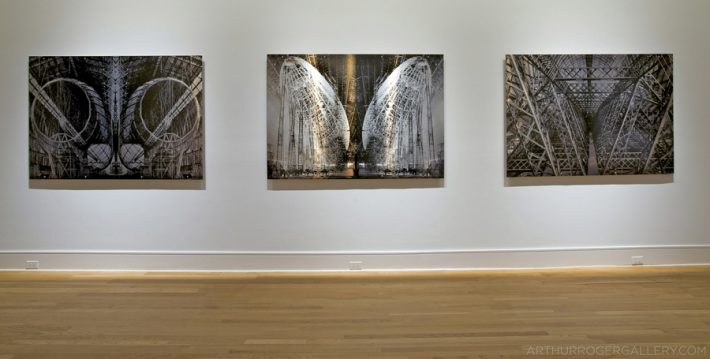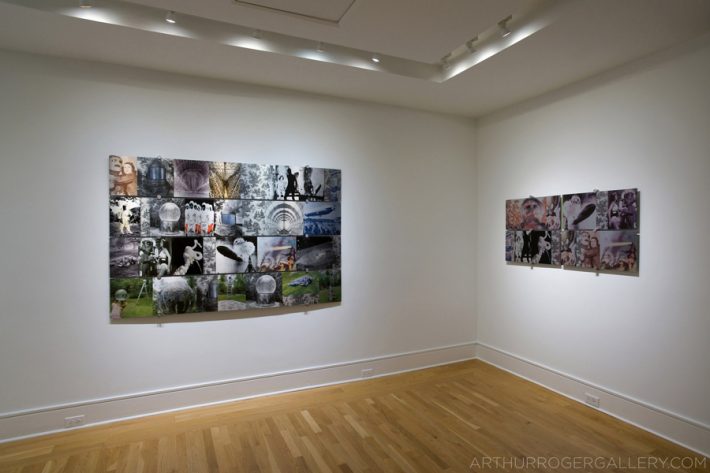by Kathy Rodriguez, via New Orleans Art Review

Dawn DeDeaux: The Mantle. 2016-17. Aluminum mantle with orbs and objects. 60 x 72 inches high.
DAWN DEDEAUX
“I’ve Seen The Future And It Was Yesterday”
Arthur Roger Gallery
New Orleans, LA
I CLEARLY REMEMBER walking through Dawn DeDeaux’s installation MotherShip III: The Station near the intersection of Elysian Fields and St. Claude Avenues. It was close to the end of the biennial (as it was structured then) in the late afternoon, overcast, with temperatures in that New Orleanian limbo area between warmth and chill. I approached the site as I would any dilapidated, disheveled urban place, with caution and intrigue. After stepping through the damp leaves and bits of detritus that always populate such places, I came upon the giant ring. The scale of it felt revelatory – it was monumental, like a giant triumphal arch leaning in preparation for being officially installed.
The “RING,” according to DeDeaux’s website, is the “first truss ring hoisted to build an airship” that would bring mankind to its next destiny. In this way it can read as cervical, the initial ring in birthing a new future. However hopeful this may sound, DeDeaux also claims it as a symbol of marriage between man and technology, which, as relationships are wont to be, is steeped in dysfunction as well as creative production. Traditionally, it is a symbol of the infinite, without beginning or end. It refers to cycles of death and life, destruction and creation, and void and presence. The empty space within its boundaries has the potential to hold so much, and yet holds nothing at all.
DeDeaux repeats the motif of the ring in installations of shield-like metal structures on the walls at Arthur Roger Gallery, which are joined by two-dimensional wall works and smaller sculptural installations. The first of these greets the viewer at the door: it is a silvery mantle decorated with a relief of two classical female figures atop symmetrical pillars, caryatids of a kind, whose arms stretch toward grapevines and apple and olive branches.

Dawn DeDeaux, Installation view. Arthur Roger Gallery.
This Neoclassical imagery decorates what is essentially a reliquary for the ideals of empire, or at least power. Iconic objects associated with power, such as miniature versions of the Tower of Pisa, a horse minus its rider, a metal briefcase traditionally used to hold cold cash, and a rifle sit atop the mantle. These symbols are more overt than the decaying aluminum can, toy truck, and teacup that join the collection of objects, but these desiccating forms also speak to human invention and intervention on the land and the environment. Humankind has built up a lot of trash, DeDeaux seems to say, and the skull and a reproduction of Masaccio’s Expulsion of Adam and Eve, which also join the array, convey DeDeaux’s concrete belief that humans have ruined their land. Death is the only expectation we may firmly keep.
These relics relate to the Souvenirs of Earth that populated her outdoor site for Prospect 3, which sat vulnerably on makeshift shelves in New Orleans’ mild winter climate. Inside the gallery space, the keepsakes are memorialized. Their metallic sheens impart both a sense of value and nostalgia, as well as the cold veneer of inaccessibility. Though they are touchable and present, they feel like mementoes behind glass, able to tell stories about their purposes but unable to relate, almost like the pre-recorded voices emanating from the “talking rings” in the 1960s version of H.G. Wells’ The Time Machine.
To the left of the Mantle installation is another in which the detail from Masaccio’s fresco is reproduced across a shield that is elevated slightly off the ground and mounted to a broken aluminum ladder, also a motif in DeDeaux’s work. Ladders are technology used to easily get to different levels, and also to escape. This ladder only goes to a wall, blocking its purpose. Combined with the Masaccio, it speaks of humankind’s inability to escape the damage they have done. Cynicism is evident in that detail’s positioning at the bottom of a ladder that only hits a block; escape is futile. Medallion Mandala #1, placed next to it, functions as an object of meditation, to ease acceptance of this inevitable fate.

Dawn DeDeaux, Installation view. Arthur Roger Gallery.
Two installations of wall-mounted disks fill the corners of the large gallery at the front of the space. To the left, a grouping of objects titled Remembering Clouds and Power (Eight Wires) and Remembering Clouds and Light, which picture abstract visions of sky in reflective grisaille, join Graffiti Planet, a three-dimensional version of a nearby print that shows Earth striped with orange paint. The toxic color relates to Agent Orange, the defoliant that caused so many neurological issues as a result of its use. As such, the image refers to the artificial deforestation enacted by man on Earth, as well as the psychological devastation resulting from complete destruction of one’s habitat and home. The convex, round forms that encase the imagery of atmospheric effects act like fragile bubbles in a vanitas painting – emblems of the fragility of life.
To the rear of the gallery, a similar installation of wall-mounted “shields” depict Pop icon Andy Warhol and the celebrities he celebrated in his work, such as Elizabeth Taylor, Marilyn Monroe, and the Mona Lisa. Warhol’s repetition of their portraits was a metaphor for the way repetition in general depletes the original content of the image, as well as democratizes it, taking away a layer of celebrity at the same time as sympathizing with the deconstruction of original self that celebrity incurs. While a public might feel nostalgic, or idolatrous, about these individuals, Warhol’s work insists that those feelings are immaterial and shallow. DeDeaux’s choice of these images also suggests the superficial feelings that humankind associates with power, and particularly in the case of Monroe, how fleeting that power can be. The inclusion of Jasper Johns’ target and a spattered U.S. flag mixed in with the crowd appear to emphasize the concept.
DeDeaux reproduced the faces of Bernini’s St. Teresa in Ecstasy and the Virgin of Michelangelo’s Pietá of the late 15th century, carved in his youth, in this arrangement as well. Bernini’s sculpture has been read as an expression of the kind of abandon that humans can only experience during the rapture of sex, which was a clear way of communicating the experience of the saint – important in the realism of the Baroque. Combined with the image of the Virgin, DeDeaux appears to comment on various roles that women fill in particular, as carriers of the new future and both mystical and carnal creatures. Each looks toward the interior of the grouping, as though watching humans’ lust for material/immaterial objects from a spiritual realm.

Dawn DeDeaux, Installation view. Arthur Roger Gallery.
Framed works on the adjacent wall picture various places of transit, particularly the JFK airport currently undergoing renovation (itself in a moment of transition). DeDeaux’s fascination with dirigibles is evident in her digital prints on aluminum in the next gallery, which formally explore the grids and structures used to create these vast and floating objects. Pictures of airports digitally rendered with a filter that produces the appearance of wilting, melting metal match with the zeppelin images – while the latter are devoted to the monumental grandeur of the airships, the former speak about the tenuous moment when any human embarks on a journey, and how delicate and uncertain the future from that moment can be.
Larger prints in the back of the gallery are filled with imagery from sci-fi movies and stills of the explosion of the Hindenburg. Portraits of space suits overlaid with floral imagery, or against a background of trees, join these prints as considerations of the reality sci-fi will become, when humans leave the earth. Apparently it will involve a continued interest in decoration and self-representation, which is evinced in 35,000 years of image making at least. While humankind may not persist as a race, its narcissistic ways will.
One sculpture in the corner between the large and small galleries, Planet on Column, is the final punctuation in this exhibition about inevitable loss, persistent memory, and fated decline. An orb dripped with black paint perches on top of a tall pillar, inscribed with foreboding and crudely written text. It may serve as a vulnerable relic, comparable in purpose to Hammurabi’s Code, but abject. The reference to upheld beliefs and law rendered in base materials, isolated in a corner, reads as one of the most cynical – or perhaps realist – works in the exhibit.
There is no escaping the fact that the environment is changing, we must brace for change, and we must expect devastation. That lesson was already learned hard and fast in just over a decade ago, in this home. DeDeaux will travel this work to an exhibition in May of this year, at MASS MoCA – the month before hurricane season starts. Though located in the northwest corner of the state, Massachusetts is still in a coastal area, and one that has become more threatened by Atlantic storms in recent years. DeDeaux, a New Orleans native, is clear that the devastation experienced here is global in its possibilities. Sharing it through the language of art history, science fiction, and reinventing familiar objects makes it relatable and understandable. The work should evoke human reflection through its shiny, mirrored surfaces, and hopefully, empathy.
